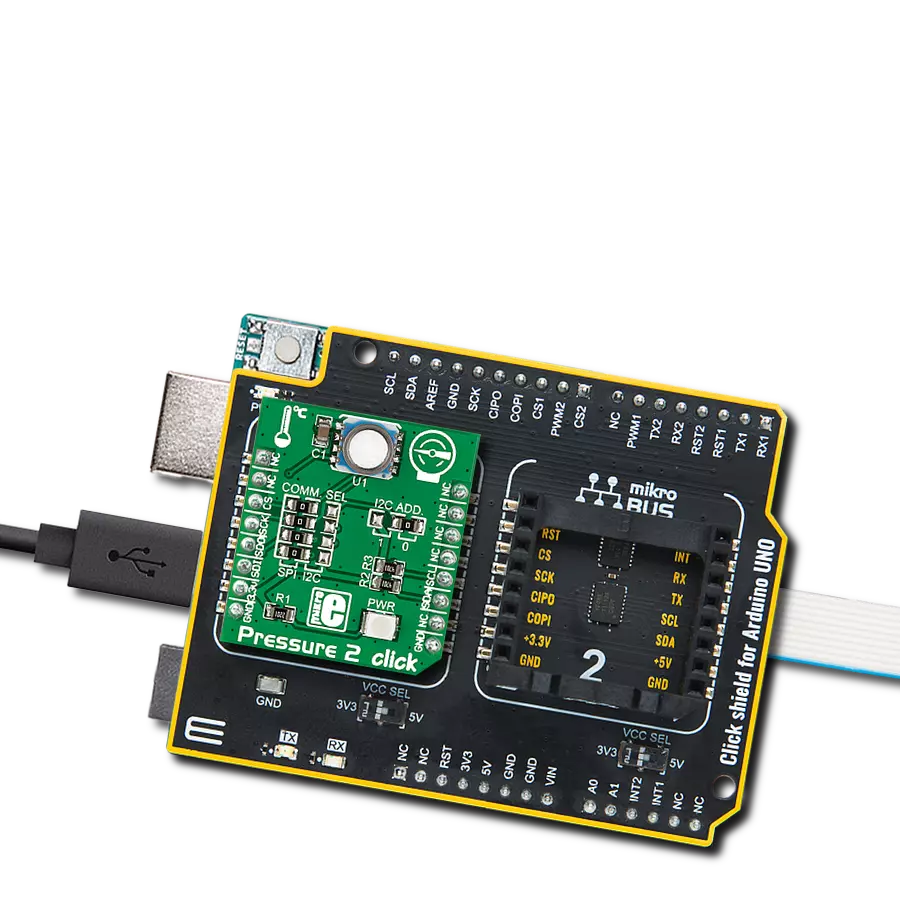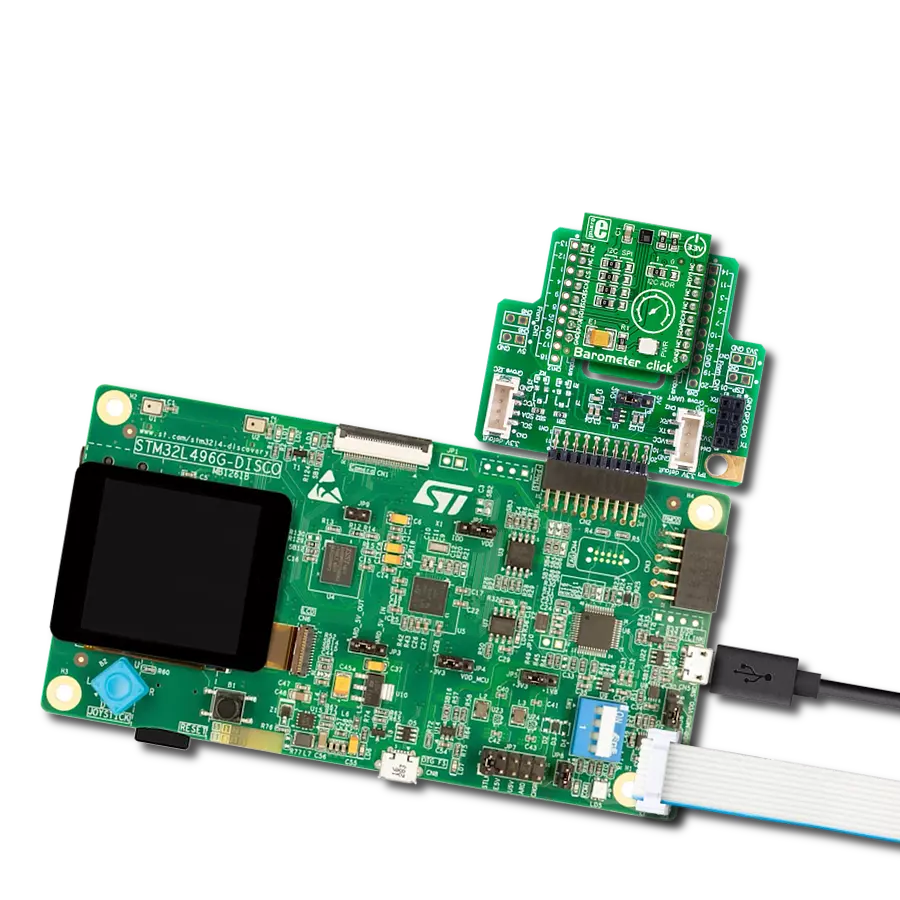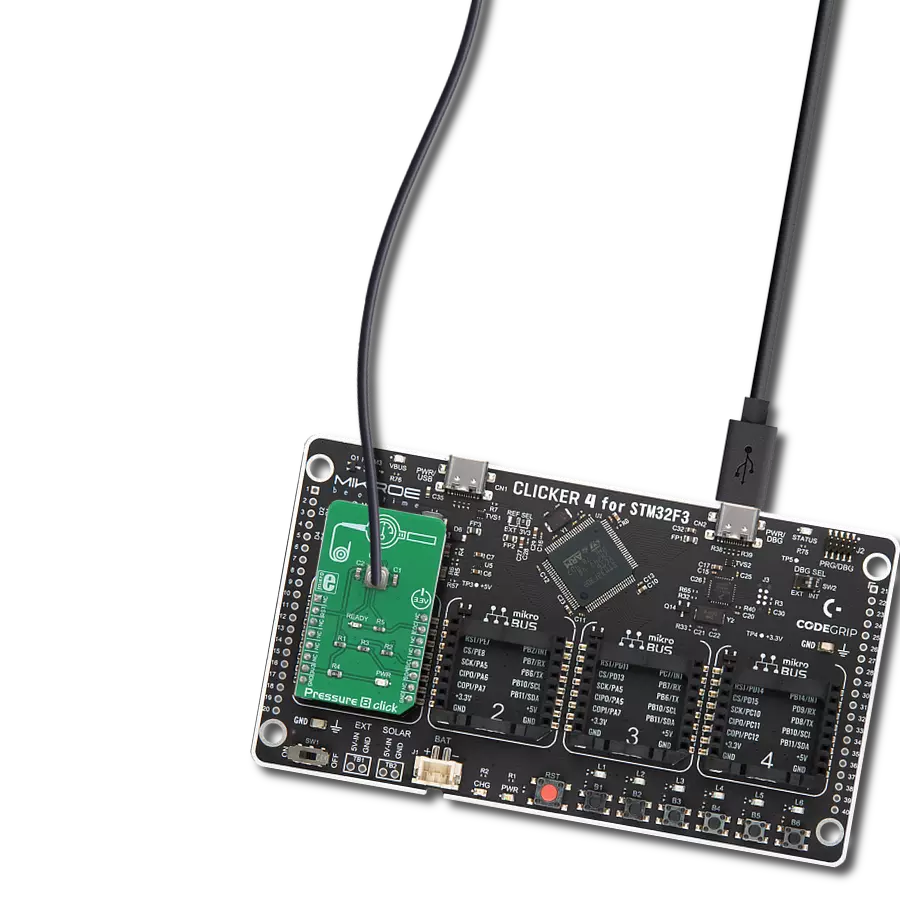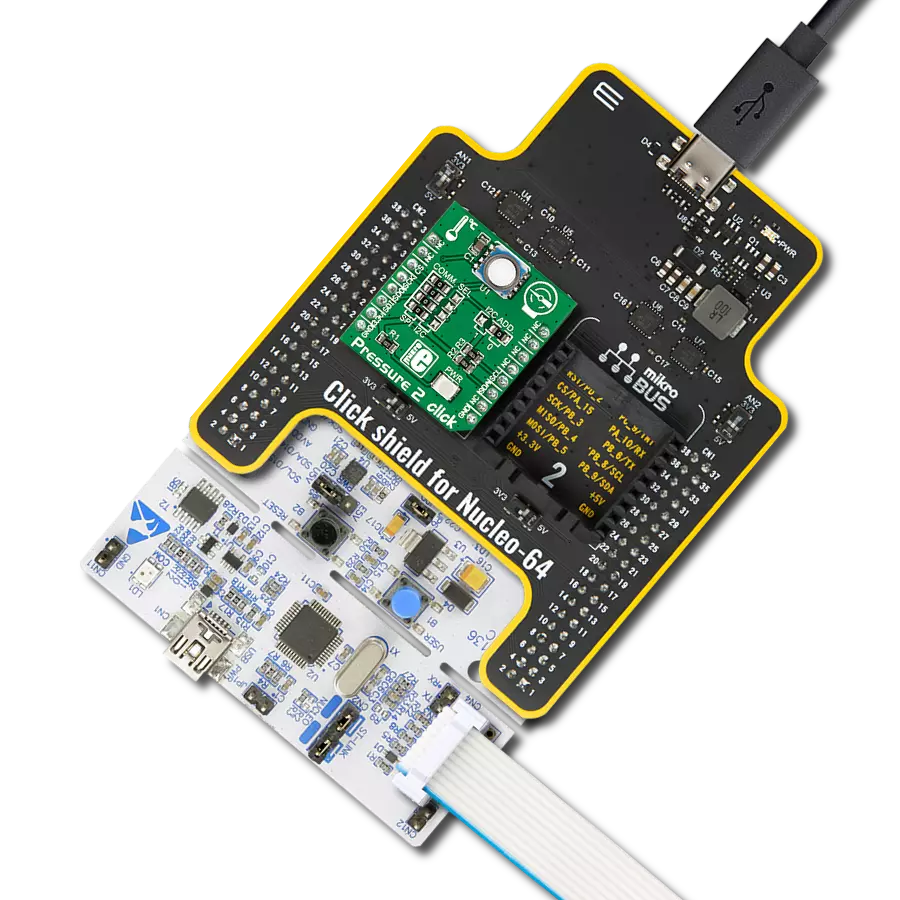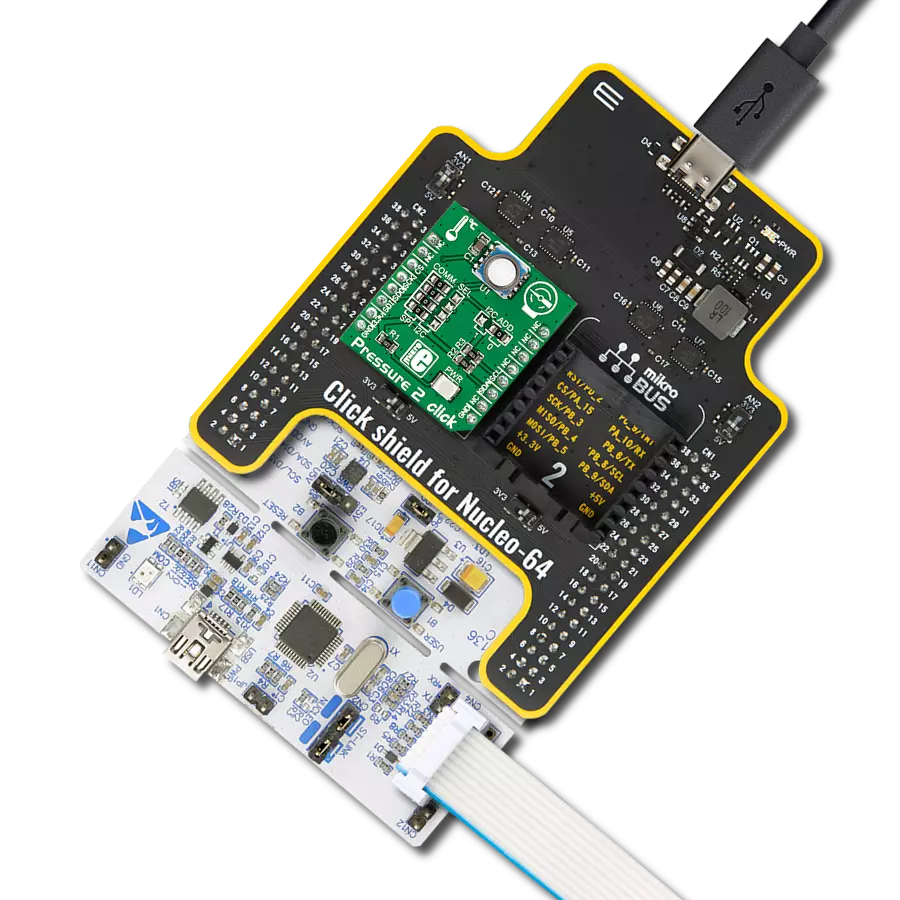Measure pressure accurately, with a typical relative accuracy of ±0.1mbar and an absolute accuracy of ±2mbar, even when subjected to high pressures
A
A
Hardware Overview
How does it work?
Pressure Click is based on the LPS331AP, a high accuracy, low-power 24-bit absolute barometric pressure sensor from STMicroelectronics. The LPS331AP provides a typical relative accuracy over pressure of ±0.1mbar and absolute accuracy of ±2mbar with high overpressure capability. It measures absolute pressure from 260mbar to 1260mbar over a wide operating temperature range. The complete device includes a sensing element based on a piezoresistive Wheatstone bridge and an interface that takes the information from the sensing element to the host MCU as a digital signal. The sensing element consists of a suspended membrane realized inside a single mono-silicon substrate capable of detecting
pressure, manufactured using a dedicated process developed by ST called VENSENS. This process allows building of a mono-silicon membrane above an air cavity with a controlled gap and defined pressure. On the other hand, the LPS331AP's interface is manufactured using a standard CMOS process and factory calibrated at three temperatures and two pressures for sensitivity and accuracy. Pressure Click allows using both I2C and SPI interfaces. The selection can be made by positioning SMD jumpers labeled as COMM SEL in an appropriate position. Note that all the jumpers' positions must be on the same side, or the Click board™ may become unresponsive. While the I2C interface is selected, the LPS331AP allows
choosing the least significant bit (LSB) of its I2C slave address using the SMD jumper labeled I2C ADD. This Click board™ also possesses an additional interrupt pin, routed to the INT pin on the mikroBUS™ socket, indicating when a specific pressure event occurs. This Click board™ can only be operated with a 3.3V logic voltage level. The board must perform appropriate logic voltage level conversion before using MCUs with different logic levels. Also, this Click board™ comes equipped with a library containing easy-to-use functions and an example code that can be used as a reference for further development.
Features overview
Development board
PIC18F57Q43 Curiosity Nano evaluation kit is a cutting-edge hardware platform designed to evaluate microcontrollers within the PIC18-Q43 family. Central to its design is the inclusion of the powerful PIC18F57Q43 microcontroller (MCU), offering advanced functionalities and robust performance. Key features of this evaluation kit include a yellow user LED and a responsive
mechanical user switch, providing seamless interaction and testing. The provision for a 32.768kHz crystal footprint ensures precision timing capabilities. With an onboard debugger boasting a green power and status LED, programming and debugging become intuitive and efficient. Further enhancing its utility is the Virtual serial port (CDC) and a debug GPIO channel (DGI
GPIO), offering extensive connectivity options. Powered via USB, this kit boasts an adjustable target voltage feature facilitated by the MIC5353 LDO regulator, ensuring stable operation with an output voltage ranging from 1.8V to 5.1V, with a maximum output current of 500mA, subject to ambient temperature and voltage constraints.
Microcontroller Overview
MCU Card / MCU

Architecture
PIC
MCU Memory (KB)
128
Silicon Vendor
Microchip
Pin count
48
RAM (Bytes)
8196
You complete me!
Accessories
Curiosity Nano Base for Click boards is a versatile hardware extension platform created to streamline the integration between Curiosity Nano kits and extension boards, tailored explicitly for the mikroBUS™-standardized Click boards and Xplained Pro extension boards. This innovative base board (shield) offers seamless connectivity and expansion possibilities, simplifying experimentation and development. Key features include USB power compatibility from the Curiosity Nano kit, alongside an alternative external power input option for enhanced flexibility. The onboard Li-Ion/LiPo charger and management circuit ensure smooth operation for battery-powered applications, simplifying usage and management. Moreover, the base incorporates a fixed 3.3V PSU dedicated to target and mikroBUS™ power rails, alongside a fixed 5.0V boost converter catering to 5V power rails of mikroBUS™ sockets, providing stable power delivery for various connected devices.
Used MCU Pins
mikroBUS™ mapper
Take a closer look
Click board™ Schematic

Step by step
Project assembly
Track your results in real time
Application Output
1. Application Output - In Debug mode, the 'Application Output' window enables real-time data monitoring, offering direct insight into execution results. Ensure proper data display by configuring the environment correctly using the provided tutorial.

2. UART Terminal - Use the UART Terminal to monitor data transmission via a USB to UART converter, allowing direct communication between the Click board™ and your development system. Configure the baud rate and other serial settings according to your project's requirements to ensure proper functionality. For step-by-step setup instructions, refer to the provided tutorial.

3. Plot Output - The Plot feature offers a powerful way to visualize real-time sensor data, enabling trend analysis, debugging, and comparison of multiple data points. To set it up correctly, follow the provided tutorial, which includes a step-by-step example of using the Plot feature to display Click board™ readings. To use the Plot feature in your code, use the function: plot(*insert_graph_name*, variable_name);. This is a general format, and it is up to the user to replace 'insert_graph_name' with the actual graph name and 'variable_name' with the parameter to be displayed.

Software Support
Library Description
This library contains API for Pressure Click driver.
Key functions:
pressure_generic_single_write- Generic Single Write functionpressure_generic_multiple_read- Generic Multiple Read functionpressure_get_pressure- Pressure Get function
Open Source
Code example
The complete application code and a ready-to-use project are available through the NECTO Studio Package Manager for direct installation in the NECTO Studio. The application code can also be found on the MIKROE GitHub account.
/*!
* \file main.c
* \brief Pressure Click example
*
* # Description
* This is a example which demonstrates the use of Pressure Click board.
* Measured pressure and temperature data from the LPS331AP sensor on Pressure
* Click.
*
* The demo application is composed of two sections :
*
* ## Application Init
* Initializes I2C/SPI serial interface and puts a device to the initial state.
* Also initializes UART console module for results logging.
*
* ## Application Task
* Reads the pressure and temperature results in standard units when
* measurement was done and sends results to the console (usb uart terminal).
* Repeats operation every 500ms.
*
* \author Nemanja Medakovic
*
*/
// ------------------------------------------------------------------- INCLUDES
#include "board.h"
#include "log.h"
#include "pressure.h"
// ------------------------------------------------------------------ VARIABLES
static pressure_t pressure;
static log_t console;
static const uint8_t deg_cels[ 3 ] = { 176, 'C', 0 };
// ------------------------------------------------------ APPLICATION FUNCTIONS
void application_init( void )
{
pressure_cfg_t pressure_cfg;
log_cfg_t console_cfg;
/**
* Logger initialization.
* Default baud rate: 115200
* Default log level: LOG_LEVEL_DEBUG
* @note If USB_UART_RX and USB_UART_TX
* are defined as HAL_PIN_NC, you will
* need to define them manually for log to work.
* See @b LOG_MAP_USB_UART macro definition for detailed explanation.
*/
LOG_MAP_USB_UART( console_cfg );
log_init( &console, &console_cfg );
log_info( &console, "---- Application Init ----" );
// Click initialization.
pressure_cfg_setup( &pressure_cfg );
PRESSURE_MAP_MIKROBUS( pressure_cfg, MIKROBUS_1 );
pressure_init( &pressure, &pressure_cfg );
pressure_sw_reset( &pressure );
pressure_default_cfg( &pressure );
}
void application_task( void )
{
uint8_t status;
float press;
float temp;
status = pressure_get_status( &pressure, PRESSURE_FLAG_MASK_P_DATA_RDY |
PRESSURE_FLAG_MASK_T_DATA_RDY );
while ( !status )
{
status = pressure_get_status( &pressure, PRESSURE_FLAG_MASK_P_DATA_RDY |
PRESSURE_FLAG_MASK_T_DATA_RDY );
}
press = pressure_get_pressure( &pressure );
temp = pressure_get_temperature( &pressure );
log_printf( &console, "** Pressure is %.2f mbar\r\n", press );
log_printf( &console, "** Temperature is %.2f ", temp );
log_printf( &console, "%s\r\n", deg_cels );
log_printf( &console, "**************************************\r\n" );
Delay_ms ( 500 );
}
int main ( void )
{
/* Do not remove this line or clock might not be set correctly. */
#ifdef PREINIT_SUPPORTED
preinit();
#endif
application_init( );
for ( ; ; )
{
application_task( );
}
return 0;
}
// ------------------------------------------------------------------------ END























